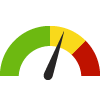Indicator Gauge Icon Legend
Legend Colors
Red is bad, green is good, blue is not statistically different/neutral.
Compared to Distribution
 the value is in the best half of communities.
the value is in the best half of communities.
 the value is in the 2nd worst quarter of communities.
the value is in the 2nd worst quarter of communities.
 the value is in the worst quarter of communities.
the value is in the worst quarter of communities.
Compared to Target
 meets target;
meets target;  does not meet target.
does not meet target.
Compared to a Single Value
 lower than the comparison value;
lower than the comparison value;
 higher than the comparison value;
higher than the comparison value;
 not statistically different from comparison value.
not statistically different from comparison value.
Trend

 non-significant change over time;
non-significant change over time; 
 significant change over time;
significant change over time;  no change over time.
no change over time.
Compared to Prior Value
 higher than the previous measurement period;
higher than the previous measurement period;
 lower than the previous measurement period;
lower than the previous measurement period;
 no statistically different change from previous measurement period.
no statistically different change from previous measurement period.
 Significantly better than the overall value
Significantly better than the overall value
 Significantly worse than the overall value
Significantly worse than the overall value
 No significant difference with the overall value
No significant difference with the overall value
 No data on significance available
No data on significance available
Percent of Students Scoring at or Above Standard for Upper Body Strength
This indicator is archived and is no longer being updated. Click to learn more
California Physical Fitness Testing
Fitness Tests
Upper Body Strength
- Push-up. The objective of this test is to complete as many 90° push-ups as possible at a pace of one 90° push-up every three seconds.
- Modified Pull-up. The objective of this test is to successfully complete as many modified pull-ups as possible. The Pull-up test was discontinued in 2006.
- Flexed Arm Hang. The objective of this test is to hang with the chin above a bar as long as possible.
County: Monterey
Measurement period: 2018-2019
Maintained by: County of Monterey
Last update: April 2022
Graph Selections
Data Source
- California Department of Education (CDE), Physical Fitness Testing (PFT)
Maintained By: County of Monterey
Filed under: Health, Health / Adolescent Health, Health / Children's Health, Health Status, Health Outcomes, Children, Teens, Parents or Caregivers


